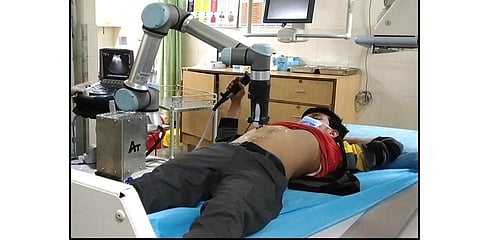

Keeping the Covid contactless protocol in mind, teams from IIT-Delhi, AIIMS New Delhi and Addverb Technologies have developed a Telerobotic Ultrasound system that has made remote ultrasound a reality. The IIT-Delhi team has been led by Professor Chetan Arora (Computer Science and Engineering department) and Professor Subir Kumar Saha (Mechanical Engineering department.
“In June 2020, Krithika Rangarajan, an AIIMS doctor who does research with my colleague Chetan Arora, asked us if we could make an ultrasound device without the patient coming in touch with the radiologist. We said yes. I asked Robotics company Addverb to collaborate on it, and they purchased a robot for us from their CSR funds. Then, my PhD student Deepak Raina (a PMRF Research scholar) started working on it,” recalls Saha. The AIIMS team comprising Rangrarajan and Ayushi Agarwal would go on to be led by Dr Chandrashekhara, while Suvayan Nandi and Hardeep Singh contributed from Addverb Technologies.
In the routine ultrasound setting, the radiologist stands in close contact with the patient for the entire scan duration. “But here we have set this up in a big room with patients in one corner of the room and doctors in the other. We have to tell the robot to tilt at an appropriate angle and put the force up to an extent that it gets good quality ultrasound images to do the diagnosis but it shouldn’t harm the patient,” adds Saha.
After the robot was imported by Addverb, the IIT team started working on different control algorithms. “Since the doctor is not a programmer here, the doctor’s input comes from the haptic device (another tiny robot) - mechanical device that mediates communication between the user and the computer device. This is called teleoperation, where the haptic device is a master and the robot is a slave. The robot can move in 3D space, similar to hand-guidance of a probe,” he shares. A safety switch is given to the patient and the doctor. If either of them feels a threat, they can press it and the power will be cut off.
“Before we shifted it to AIIMS in March, doctors visited the plant in Noida and gave us feedback. A total of 30 ultrasounds have been done using the machine till now. I am hopeful we will have a fool proof system soon. After that, we will obtain the necessary certification before anyone can use the technology,” Dr Saha shares. Saha and team recently published a paper on this research and will present it in a conference in Georgia Tech. University, Atlanat, USA. As of now, this has been a voluntary effort.
“A robot costs `20 lakh. But if we get big funds, we can start to duplicate it. Our goal is to take this system to remote places, where the internet can be used to send the input, so that a doctor sitting at a city hospital can examine patients from rural areas,” concludes Saha.